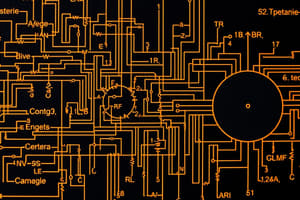Podcast
Questions and Answers
What is the output of the expression A ∧ B when A = 1 and B = 0?
What is the output of the expression A ∧ B when A = 1 and B = 0?
- False
- 0 (correct)
- 1
- True
Which Boolean operator inverts the value of its operand?
Which Boolean operator inverts the value of its operand?
- XOR
- NOT (correct)
- AND
- OR
According to the Complement Law, which statement is true?
According to the Complement Law, which statement is true?
- A ∧ ¬A = 0 (correct)
- A ∨ ¬A = 0
- A ∧ 1 = A
- A ∨ 1 = 0
What does the NAND operator output when both operands are true?
What does the NAND operator output when both operands are true?
Which law states that A ∨ 0 = A?
Which law states that A ∨ 0 = A?
What is the result of the expression ¬(A ∨ B) when both A and B are false?
What is the result of the expression ¬(A ∨ B) when both A and B are false?
How does the Distributive Law apply to the expression A ∧ (B ∨ C)?
How does the Distributive Law apply to the expression A ∧ (B ∨ C)?
In a truth table representing the expression A ∨ B, how many rows would be included if both A and B are binary variables?
In a truth table representing the expression A ∨ B, how many rows would be included if both A and B are binary variables?
Flashcards are hidden until you start studying
Study Notes
Boolean Expressions
-
Definition:
- Boolean expressions are algebraic expressions that evaluate to either true (1) or false (0) using Boolean variables and operators.
-
Boolean Variables:
- Can take values of either 0 (false) or 1 (true).
-
Basic Operators:
- AND ( ∧ )
- Output is true only if both operands are true.
- Example: A ∧ B is true if A = 1 and B = 1.
- OR ( ∨ )
- Output is true if at least one operand is true.
- Example: A ∨ B is true if A = 1 or B = 1 or both.
- NOT ( ¬ )
- Inverts the value of the operand.
- Example: ¬A is true if A is false (A = 0).
- AND ( ∧ )
-
Other Operators:
- NAND (¬(A ∧ B))
- Output is false only if both operands are true.
- NOR (¬(A ∨ B))
- Output is true only if both operands are false.
- XOR (A ⊕ B)
- Output is true if exactly one operand is true.
- NAND (¬(A ∧ B))
-
Expression Examples:
- A ∧ B
- A ∨ (B ∧ C)
- ¬(A ∨ B)
-
Laws of Boolean Algebra:
- Identity Law:
- A ∧ 1 = A
- A ∨ 0 = A
- Null Law:
- A ∧ 0 = 0
- A ∨ 1 = 1
- Idempotent Law:
- A ∧ A = A
- A ∨ A = A
- Complement Law:
- A ∧ ¬A = 0
- A ∨ ¬A = 1
- Distributive Law:
- A ∧ (B ∨ C) = (A ∧ B) ∨ (A ∧ C)
- A ∨ (B ∧ C) = (A ∨ B) ∧ (A ∨ C)
- Identity Law:
-
Simplification:
- Boolean expressions can often be simplified using laws to reduce complexity.
-
Truth Tables:
- A systematic way to represent the output of Boolean expressions for all possible input combinations.
-
Applications:
- Used in digital circuit design, computer science, and logic programming.
This summarizes the key concepts of Boolean expressions within Boolean algebra.
Boolean Expressions Overview
- Boolean expressions evaluate to true (1) or false (0) using Boolean variables and operations.
- Boolean variables can only hold values of 0 (false) or 1 (true).
Basic Operators
- AND ( ∧ ): True if both operands are true; example: A ∧ B is true if A = 1 and B = 1.
- OR ( ∨ ): True if at least one operand is true; example: A ∨ B is true if A = 1 or B = 1 or both.
- NOT ( ¬ ): Inverts the value of the operand; example: ¬A is true if A is false (A = 0).
Other Operators
- NAND (¬(A ∧ B)): True unless both operands are true.
- NOR (¬(A ∨ B)): True only if both operands are false.
- XOR (A ⊕ B): True if exactly one operand is true.
Expression Examples
- Common expressions include A ∧ B, A ∨ (B ∧ C), and ¬(A ∨ B).
Laws of Boolean Algebra
- Identity Law: A ∧ 1 = A and A ∨ 0 = A
- Null Law: A ∧ 0 = 0 and A ∨ 1 = 1
- Idempotent Law: A ∧ A = A and A ∨ A = A
- Complement Law: A ∧ ¬A = 0 and A ∨ ¬A = 1
- Distributive Law:
- A ∧ (B ∨ C) = (A ∧ B) ∨ (A ∧ C)
- A ∨ (B ∧ C) = (A ∨ B) ∧ (A ∨ C)
Simplification
- Boolean expressions can be simplified using algebraic laws, reducing complexity and improving efficiency.
Truth Tables
- Truth tables systematically represent the output of Boolean expressions for all possible combinations of input values.
Applications
- Boolean expressions are fundamental in digital circuit design, computer science, and logic programming, facilitating logical operations and decision-making processes.
Studying That Suits You
Use AI to generate personalized quizzes and flashcards to suit your learning preferences.




